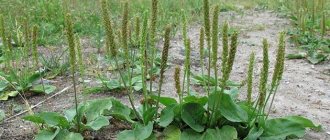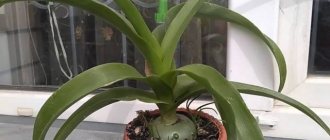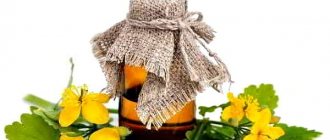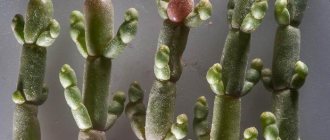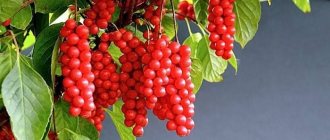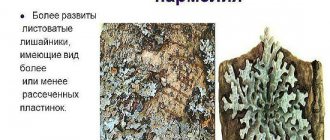Harvesting and storing plantain
Harvesting plantain
Collection is carried out in the summer, as well as in September, after flowering.
It is recommended to harvest plantain whole, along with roots and seeds. But if the seeds are of particular importance, you should wait until they are fully ripe, i.e. they acquire a brownish-brown color
The leaves are collected several times during the season; they do not lose their beneficial properties.
To harvest the plant, choose the morning time and dry, not rainy, laziness. The most valuable plants will be those that grow far from roads and away from the scorching sun.
The plantain is carefully dug under the root and removed entirely. When harvesting leaves, they are cut with scissors at a distance of a couple of centimeters from the ground.
Preparation, drying, storage, freezing
- The preparation includes washing under running water and dividing into the necessary parts (leaves, roots, seeds).
- Drying is carried out in a well-ventilated place, excluding exposure to direct sunlight (canopy, attic, balcony). The parts of the plant are laid out freely on a sheet of clean paper and dried until completely dry. The raw materials should be turned periodically for better drying.
- Freezing - this method of preparing plantain is also allowed. The leaves of the plant, washed and completely dry from water, are frozen using the deep freezing method.
- Dry plantain is stored in fabric bags, paper bags or wooden boxes in a dark and well-ventilated place. Dry raw materials can be used within 24 months, frozen - within six months.
- Preparing juice - dilute freshly squeezed juice from petioles and leaves of plantain with vodka in a 1:1 ratio, store the liquid in the refrigerator for six months.
Varieties of plantain
In the modern world there are more than 150 species of plantain. Of these, about 30 are found in the territory of the former USSR. Most are considered weeds, although in Western countries the plant has been cultivated for its medicinal properties.
The most famous and widespread species is the common plantain or, as it is also called, large (Plantago major). This plant is used to treat wounds and bruises. Healing infusions and decoctions are prepared from the leaves and seeds, the juice is squeezed out, and the herb is used in medicinal and dietary nutrition.
The widespread distribution of medicinal herbs is due to its unpretentiousness to soil and climatic conditions. The variety grows everywhere: on clay and sand, in the sun and in the shade. Resistant to trampling and mechanical stress.
Due to its unique medicinal properties, the crop is grown on an industrial scale. This makes it easier to collect and prepare raw materials.
In addition to the ordinary one, other types of plantain are used for treatment:
- Lanceolata (Plantago lanceolata). The plant prefers damp places close to a body of water, forest clearings, clearings, and clearings. Its feature is long, upward-pointing leaves. With their elongated, pointed shape, they resemble a lancet - an ancient surgical instrument. The seed capsule contains only one seed.
- Medium (Plantago media). The plant most often settles in secluded places in the Moscow region and central Russia - in meadows, former arable lands, in sparse forests, along the sides of trails. In appearance it is similar to large plantain, differing only in the pubescence of the underside of the leaves.
- Sandy (Plantago arenaria). It is also called flea, Indian, rough. Unlike other plantains, it is an annual. The plant is distributed throughout the world in areas with mild, temperate climates; in Ukraine it is cultivated as a valuable medicinal variety. Seeds and fresh grass are used as medicinal raw materials.
Depending on the variety and place of growth, plantains bloom from May to September. With a lag of a month, the fruits—pods with seeds—begin to ripen.
About benefits and application
We all know that if you apply plantain to a wound, you can stop the bleeding, prevent the formation of an inflammatory process, and the wound itself will heal faster. This truth has been known for a long time, although this plant did not immediately reveal its properties to people. Today, unfortunately, not many people use the gifts of nature, but natural preparations are much more effective than many modern medicines and also have a more gentle effect.
By using plantain tincture you can get rid of the following problems without harm to the body:
- upper respiratory tract diseases;
- infertility in men and women;
- gastritis;
- acute colitis;
- stomach ulcer;
- digestive disorders;
- cystitis;
- bruises, burns, wounds.
Medical experts have proven that plantain tincture, when combined with complex treatment, helps alleviate the condition of patients suffering from tuberculosis and lung cancer.
The whole secret of this plant lies in its juice, which is capable of exhibiting bactericidal and wound-healing effects. For this reason, such an unremarkable herb has found wide application in both folk and traditional medicine. And today it can be useful to each of us - some stop bleeding, others treat coughs, others use it for cosmetic purposes, and some even in cooking.
Dangerous properties of the herb and contraindications
Folk remedies or herbal preparations should not be taken simultaneously with lithium-containing medications, because they reduce the therapeutic effect of the latter. Active plant components slow down the absorption of lithium.
Abuse of grass is strictly prohibited. Otherwise, an overdose develops, characterized by the following symptoms:
- prolonged sneezing;
- increased tearfulness;
- feeling of compression behind the sternum;
- allergy;
- bronchial asthma.
Medicines containing plantain are prohibited from taking if there are the following contraindications:
- ulcerative lesions of the stomach and duodenum;
- individual intolerance to components, hereditary predisposition to the occurrence of anaphylactic reactions;
- hyperacid gastritis;
- increased acidity of gastric juice, frequent heartburn and stool disorders;
- increased blood clotting;
- tendency to thrombosis;
- varicose veins of the lower extremities.
Failure to comply with the rules for taking medicinal products with the plant can cause harm to health.
Side effects
If the recommended daily dosage is exceeded, the following negative effects may develop:
- dizziness;
- pain in the epigastric region;
- heartburn;
- increased gas formation in the intestines, which is accompanied by flatulence and bloating;
- hyperemia;
- severe itching;
- swelling of the upper respiratory tract, bronchospasm;
- diarrhea;
- rashes.
About the plant
Description of the plant:
- 1. Height - from 5 to 40 cm, varies greatly depending on the properties of the soil.
- 2. The stem is short (therefore the leaves are located on the earth’s surface); only during flowering do 1-3 (rarely more) unbranched peduncle shoots develop. They are straight, sparsely pubescent, grow from the mouth of the leaves.
- 3. Leaves – oval or ovoid, green, leathery, growing from the base of the plant up to 12 cm in length. Clearly defined longitudinal veins are visible on their surface. The leaves have long, rigid petioles that grow from a short underground rhizome, forming a dense rosette above the ground.
- 4. Flowers - small, with a brown-green or white-yellow corolla, located one at a time in the axil of the bract.
- 5. Fruit - is an ovoid, multi-seeded capsule with small seeds located in each nest in the amount of 4-16 pieces. Ripe seeds spill out of the nest directly onto the ground. In wet weather, they secrete mucus, thanks to which they cling to the fur of animals or the soles of human shoes and are transported over considerable distances. Mature seeds can begin to germinate in the same year in which they fell into the ground (late summer or early autumn).
- 6. Flowering time - late spring and until the end of summer.
There are 150 species of this plant. The most common:
- 1. Large or ordinary - found almost everywhere. A compress of its leaves is used for bruises, wounds, and boils. An alcoholic tincture from the plant helps lower blood pressure.
- 2. Lanceolate. It is characterized by the presence of long leaves that have healing properties. The plant is used for whooping cough and bronchitis.
- 3. Medium or flea - grows mainly in the Caucasus. This herb is the main component of effective laxatives.
Plantain leaves should be collected from spring to autumn. The first time is at the beginning of April, and the second time is at the end of the growing season. Material collection is carried out in clean places, on warm and dry days.
You should pay attention to ensure that the leaves are young, healthy and free of dust.
The collected raw materials can be used for various purposes. Juices, tinctures, and ointments made from it are used internally and directly on the skin. The preparation of dry raw materials is carried out in natural dryers or in heated rooms, and it should be remembered that the temperature should not exceed 40 °C.
A few words about the plant
Great plantain, which is the name of this plant, has long been used in folk medicine. In addition to cough and the treatment of male problems, drugs made on its basis can be used in the prevention and treatment of certain diseases of the gastrointestinal tract, including:
By the way, in addition to it, the so-called “flea chin” is also widely used, which also has certain healing properties. The prevalence of plantain has made it very accessible for use as a medicinal raw material. By the way, it grows over a fairly wide area in various countries of the world. As the name suggests, it often grows both on roadsides and along small forest paths. However, some species. Which also belong to this genus are quite rare. It is for this reason that they are protected: caring for them allows you not to worry about their complete disappearance.
Remember! In any case, you will always recognize this low medicinal plant, which can be easily distinguished from other “green fellows”.
How does the preparation take place?
Of course, any medicine is made from a previously and properly prepared plant. As for the use of the tincture of application, the first step for preparing it is to prepare the raw materials. The optimal period for this is the beginning of summer. It is at this time that the highest concentration of substances beneficial to health is observed in the plant. Of course, harvesting is allowed at other times, for example, in spring or even autumn. However, it is best to do this in the summer.
Having prepared the raw materials, they proceed to drying them. It is entirely possible to carry it out outdoors so that the leaves are blown by a light summer breeze. On the other hand, try to protect them from direct sunlight. When raw materials are dried properly, they can be stored for a very long time. So, you can make certain medicines from it for about 2 years: all the beneficial qualities will be preserved.
Features of using the tincture
The use of plantain tincture is as follows:
- For the treatment of colitis, gastritis, bronchitis and severe cough, the drug is taken orally, 3 milliliters for every 10 kilograms of weight, twice a day for 30 days;
- High blood pressure is reduced by taking the tincture orally, 30 drops three times a day;
- To quickly heal wounds, bruises, burns and other damage to the skin, the product is used for compresses. To do this, soak a piece of cotton napkin in the tincture and apply to the damaged skin. Carry out the procedures a couple of times a day until the wounds are completely healed.
The use of plantain for the treatment of long-term non-healing wounds is carried out in the form of a bactericidal and wound-healing ointment. To create it, grind dry plantain leaves and mix with three drops of vegetable oil. To one part of this mixture, add nine parts of Vaseline. The prepared ointment can also treat trophic and varicose ulcers in the lower extremities.
How to use
According to the instructions, plantain extract is consumed throughout the day. Due to its mild composition, as a rule, there are no restrictions related to the exact time of taking the drug. It can be drunk both before and after meals. Adult patients take two scoops at a time. Typically, plantain syrup is taken three times a day throughout the day. If the disease occurs in an acute form, then a five-time dose is allowed.
Children under two years of age should not use plantain extract for cough. Until the age of seven, you can drink only half a measuring spoon and no more than three times a day. From seven to fourteen they take six measuring spoons a day. The norm is distributed three times. Doctors recommend drinking the syrup with warm water.
As for pregnant women, doctors, as a rule, are not against using syrup during pregnancy. During this period, they try to reduce the dosage of the drug or shorten the period of its use.
For children
It must be borne in mind that despite the variety of beneficial qualities, any alcohol-based plantain products are prohibited for internal use by children under 15 years of age.
To treat cough, you can prepare a useful syrup, for which you finely chop the washed fresh leaves of the plant. Separately, pour 1.5 liters of water into an enamel pan. After boiling, add 500 g of sugar and a glass of prepared vegetable raw materials while stirring.
Boil for three minutes and then leave to cool. After filtering, pour the syrup into a glass vessel. Keep covered in a cool place without lighting. Take 1 tsp. Children over 3 years old are recommended every 4 hours.
Usefulness of the plant
Plantain has anti-inflammatory, antiseptic, astringent, healing, analgesic, expectorant and blood purifying properties.
Various infusions and tinctures are prepared from the leaves of the plant, which help get rid of cough, as well as tuberculosis, pleurisy, bronchial asthma and whooping cough.
Plantain leaves are enriched with components that affect cholesterol metabolism. Alcohol or water tinctures based on the plant are used to treat peptic ulcers.
Veselka mushroom, method of using tincture
Plantain juice contains antibacterial substances that help fight Pseudomonas aeruginosa and Escherichia coli, pathogenic microbes of wound infections, and hemolytic staphylococci.
The juice of the plant is often used to remove pus and germs from a wound. Thanks to its healing properties, scratches, wounds and injuries heal much faster.
The usefulness of plantain also lies in the fact that it helps to quickly cure coughs of any origin.
Useful properties of plantain
Plantain is widely used in both folk and classical medicine. All parts of the plant are used to make medicines, since they contain a huge amount of biologically active substances.
So, what are the benefits of plantain for the body? Long-term phytochemical analyzes found the following substances in the leaves of the plant:
- vitamins, microelements and natural acids that increase metabolism;
- flavonoids and tannins with antimicrobial and astringent effects;
- phenols and natural bitters provide a regenerating, anti-inflammatory effect.
Even people far from medicine know about the wound-healing and hemostatic properties of the leaves of the plant. A natural antiseptic is applied to abrasions and bruises, and infusions and decoctions are prepared from it.
Plantain roots contain plant sterols (hormone-like substances) that have a beneficial effect on hormonal levels and linoleic acid. The same components are contained in fruits and leaves, but in smaller quantities.
Almost half of plantain seeds consist of mucus, which has a beneficial effect on the gastrointestinal tract, improves intestinal motility, and prevents constipation.
The interaction of the substances considered determines the medicinal properties of plantain and contraindications for use. The most significant pharmacological effects on the body are:
- expectorant;
- enveloping;
- regenerating;
- sedative;
- antidiabetic;
- hemostatic;
- immunostimulating;
- hypotensive.
Indications for use
Plantain is officially recognized as one of the best cough remedies for colds, tonsillitis, rhinitis, acute respiratory viral infections and acute respiratory infections, influenza, laryngitis, and bronchitis. The herb helps against hemoptysis in tuberculosis; a warm infusion quickly relieves attacks of whooping cough, and also dilutes and removes mucus from the respiratory tract.
The seeds and leaves of the plant are excellent for treating peptic ulcers and gastritis with low acidity. Medicines quickly relieve pain and irritation of the intestinal walls, eliminate flatulence, improve bile secretion, and destroy staphylococcus and Pseudomonas aeruginosa. This effect makes it possible to use plantain for household poisoning and dysentery.
Even children know about the wound-healing and hemostatic qualities of the plant. It is used to treat not only abrasions and bruises, but also boils, pimples, dermatitis, and allergic rashes. A natural remedy for bites from wasps, bees and snakes. Dentists don’t forget about it either. Rinse your mouth with a strong solution for gum disease.
Plantain grass is especially useful for women. Healing decoctions are taken orally for various gynecological diseases, uterine bleeding, and are used for douching. Use infusions to wash acne, unclean facial skin, and rinse hair to remove dandruff. But the main value of the plant lies in its ability to fight infertility.
Doctors often recommend including plantain products in complex therapy for diabetes, atherosclerosis, and obesity. Plants restore metabolism, normalize blood sugar, and cleanse the body of toxins.
Contraindications
Plantain also has contraindications that you need to remember when starting treatment:
- individual intolerance to the plant;
- tendency to thrombosis;
- gastritis with high acidity.
Useful Features
The structural formula of plantain tincture contains tannins, flavonoids, and polysaccharides. There are phytoncides, emulsin, invertin.
Saponins, potassium, aucubin glycoside, vitamin K, and resins are present. Contains acids: citric, ascorbic, oleanolic. As well as sterols, mucus, carotene, bitterness. Medicinal properties:
- anti-inflammatory;
- painkillers;
- expectorants;
- anti-ulcer;
- bacteriostatic;
- wound healing;
- antiseptic;
- antiallergic;
- antispasmodic;
- sedatives;
- antimicrobial;
- regenerating;
- hemostatic;
- enveloping.
Plantain tincture improves gastric secretion, normalizes digestion, and reduces cholesterol concentrations. Indications:
- enterocolitis;
- constipation;
- hypoacid gastritis;
- trophic ulcers;
- kidney diseases;
- dysentery;
- cystitis;
- hypertension;
- atopic dermatitis;
- atherosclerosis;
- urethritis;
- burns;
- wounds;
- furunculosis;
- rhinitis;
- whooping cough;
- pneumonia;
- acne;
- bronchitis;
- dysbacteriosis;
- bronchial asthma.
Plantain tincture helps improve appetite. It is used to solve a number of gynecological problems and treat impotence. It is recommended to take it for colds, helping to quickly eliminate cough.
It is beneficial for diseases of the gastrointestinal tract. Helps with pathologies of the nervous, cardiovascular, and genitourinary systems. Improves the condition of skin and hair.
How to treat hemorrhoids with plantain
Plantain for hemorrhoids
Hemorrhoids are a disease that is best treated not only internally, but also locally. In view of this, you can, for example, take decoctions of plantain orally and, in addition to this, make lotions or douches.
By acting directly on the inflamed mucous membrane and hemorrhoids, you will achieve positive changes after the second such procedure. Douching can be done with a special device or with a rubber bulb with a small tip.
So:
- Prepare a concentrated decoction of plantain root and leaf.
- Cool it to an acceptable temperature and fill it with a syringe
- Treat the anus with anesthetic gel and insert the syringe inside
- Slowly inject the broth into the intestines and take a horizontal position
- Repeat the procedure 2 times a day until the discomfort disappears completely.
Chemical composition
Plantain decoction has undoubted benefits. The rich composition of the plant allows it to exhibit healing properties and have a beneficial effect on the body. The following components help:
- Phytoncides;
- Proteins;
- Amino acids;
- Beta-cartoene;
- Saponins;
- Bioflavonoids;
- Enzymes;
- Polysaccharides;
- Potassium, copper, iron, calcium and magnesium.
It is the combination of these elements that makes the plant unique - pay special attention to the following components in the composition:
- Polysaccharides envelop and act as an antiseptic;
- Fatty oils help regenerate tissue;
- Aucubans stimulate digestive processes and act as a diuretic. They have an anabiotic and antispasmodic effect, and have a sedative effect;
- Mineral salts regulate water balance and normalize metabolism;
- Nitrogenous substances relieve swelling;
- Oleanolic acid acts as an antispasmodic and improves blood circulation.
Plantain decoction should not be drunk uncontrollably - the use must be carefully verified and carried out according to the recipe.
We will definitely discuss how to drink the healing remedy correctly so that it helps with your illness, but first we’ll talk about the benefits and contraindications of the plant, which are important for everyone to know.
Also recommended: Acai berries
Treatment with plantain recipes
Ear pain and toothache. Place a plantain root in the ear that hurts or on the side where the tooth hurts. Hold until the pain subsides, usually this takes half an hour.
Inflammation of the eyes. 1 tbsp. Brew a spoonful of dry crushed plantain leaves with 1 cup of boiling water, boil for 2 minutes, wrap, leave to brew for 30 minutes, then strain and make compresses from the warm infusion.
Gastrointestinal diseases and atherosclerosis. Chop clean plantain leaves, remember, squeeze out the juice, mix with honey 1:1, boil for 20 minutes. Take 2-3 tbsp. spoons a day. Store in a tightly sealed container in a cool place.
Ulcer. Mix plantain and sage, take 2 tbsp. spoons of the mixture, pour 2 cups of boiling water, leave to brew, drink 1/3 cup 3 times a day before meals for 10 days, and then increase the dose to 0.5 cup. Take 1-2 months.
Colitis. Pour 1 teaspoon of plantain seeds into 1 glass of hot water, boil in a closed enamel vessel for half an hour, strain and bring the volume to the original volume with boiling water. Take 1-3 tbsp. spoons 3-5 times a day before meals.
Cholecystitis. 1 tbsp. Brew a spoonful of plantain leaves with 1 cup of boiling water, leave to brew for 10 minutes, strain. This is a daily dose and must be taken in sips within 1 hour.
Asthma, pulmonary tuberculosis, pleurisy, cough, whooping cough, chronic catarrh of the upper respiratory tract and bronchi. 1 tbsp. Pour 1 cup of boiling water over a spoonful of plantain leaves, cover and leave to stand for 1 hour. Strain, take 1 tbsp. spoon 3-4 times a day 20 minutes before meals.
Kidney disease and bedwetting. 1 tbsp. Pour 1 cup of boiling water over a spoonful of leaves, cover, leave to brew for 1 hour, strain. Take 1 tbsp. spoon 3-4 times a day 20 minutes before meals.
Chronic constipation. Take 1 tbsp on an empty stomach. spoon of plantain seeds with warm water. The effect occurs after 8-10 hours.
Menopause, heavy menstruation, infertility. 1 tbsp. Pour a glass of boiling water over a spoonful of plantain seeds, hold in a water bath for 5 minutes on the lowest heat, and cool. Take 2 tbsp warm. spoons 4 times a day.
Application for the treatment of diseases
Due to the variety of beneficial characteristics, plantain tincture is highly valued in folk medicine. Both ready-made preparations and homemade varieties are used. It is important to obtain a doctor's recommendation in advance.
For the stomach
The alcoholic extract of plantain, which has an anti-inflammatory, enveloping, analgesic effect, is considered one of the most effective remedies used in the treatment of gastric diseases.
For gastritis, 20 ml of the drug is taken three times a day with water. After a month's course there is a two-week break.
For potency
For the treatment of impotence, a homemade tincture made from plantain seed and red wine is recommended.
It is recommended to take 15 ml before breakfast and dinner. The duration of treatment therapy varies from 60 to 90 days.
For your appetite
In order to improve appetite, a water infusion is often prepared from dried plantain leaves. Soak for a quarter of an hour in 200 ml of boiled water, 1 tbsp. l. ground raw materials. In filtered form, 1 tbsp. l. drink healing liquid every eight hours.
For wounds
For external use, in order to heal skin lesions, soak a cotton pad with alcohol or vodka plantain extract.
Leave on the affected area for 20 minutes, repeating the action 3-5 times a day. It has a regenerating, disinfectant, hemostatic, analgesic, and anti-inflammatory effect.
For gums
Plantain helps against inflammation and bleeding gums. You can rub them with fresh juice from the leaves of the plant in the morning and evening.
Rinsing the mouth with alcoholic plantain extract demonstrates high effectiveness. Before the procedure, you need to dissolve 4 tbsp. l. drug in a glass of warm water. The procedure is carried out every six hours.
Against cough
A tincture (homemade or pharmacy) based on plantain leaves helps to cope even with a lingering cough.
1 tbsp. l. The medication should be taken every eight hours with warm herbal tea. Alcohol based on plantain juice and honey, use 1 tbsp. l. recommended for bronchopulmonary diseases 35-40 minutes after breakfast, lunch, dinner.
From smoking
In a targeted fight against smoking, good results are noted from the use of plantain tincture.
Recommended 1 tbsp. l. Take a home or pharmacy remedy three times a day. The course is maintained for two weeks. Then a seven-day break will be required, followed by repeating the use of the extract if the need arises.
From high blood pressure
In order to reduce high blood pressure, you will need crushed fresh plantain leaves - 20 g. They are placed in a bottle with a glass of vodka and sealed tightly.
Article for you:
Cinquefoil tincture: what it helps with, how to prepare it, use in folk medicine and cosmetology
Leave in the dark for 14 days. For treatment, 30 drops of a filtered drink dissolved in 30 ml of water are taken every eight hours.
Recipes
To make medicine from plantain, its leaves are most often used, but seeds, inflorescences and juice can also be used. The raw materials can be taken either fresh or dry, because this plant retains its beneficial properties in any form. Anyone can handle the preparation. Collect the seeds when they turn brown. This means they are fully ripe. The remaining parts of the plant can be collected from June to September.
Collect raw materials in the morning when the dew has dried. Try not to use parts of plants that grow along roads for medicine. Over time, it accumulates harmful substances and a product prepared from such plantain will do more harm than good.
Use a knife or scissors to collect. When cutting the plant, leave about 5 cm to the surface of the ground. Wash the collected plantain and dry thoroughly. Then place it on the paper. Dry the raw materials in the shade, preferably in a cool place, so that they do not begin to rot. This will take 1-2 weeks. Store the dried plant in bags or boxes.
Recipe 1
- several fresh or 25 g of dry leaves;
- 400 ml water.
Preparation
- If you are using fresh raw materials, thoroughly rinse the leaves under water and chop them. You should have 3 tbsp. l. with a small pile of raw materials.
- Pour hot, almost boiling water over the leaves.
- Infuse the drink for 1.5 hours, then strain.
Recipe 2
- 1 tbsp. l. plant seeds;
- 250 ml water.
Preparation
- Pour boiling water over the seeds. Shake for 2-3 minutes.
- Leave for 40 minutes, after which strain the drink.
Preparation
- Pour vodka over the juice or leaves of the plant.
- Place the container with the drink in a cool place.
- The plantain tincture will be ready in 2 weeks. If you used fresh leaves, strain the medicine you made.
Operating principle
Once in the stomach, the syrup stimulates an increase in mucus, which, in turn, enters the respiratory tract. Thus, it envelops the irritated tissues of the diseased organ, due to which they heal, and the cough reflex is noticeably reduced.
In addition, due to its pronounced antimicrobial properties, the number of bacteria gradually decreases. Vitamin C affects the immune system, causing it to work as hard as possible. Thanks to this syrup, the healing process goes very quickly and unnoticed. According to users, sometimes five or seven days are enough to completely get rid of cough.
How to use
When considering a medicine such as plantain tincture, the instructions for use are exactly what you need to study first. Some of the medicines can be made with your own hands, right at home. The main thing is that you be careful when making it at home. Let's look at some types of plantain-based drugs and their use for certain respiratory diseases:
When you have a cough, you can use one proven recipe. To prepare, you need to take equal parts of plantain, pine buds and coltsfoot. Place one tablespoon of the mixed ingredients on the fire, after which the broth must be boiled for 10 minutes. After this, cover the container and leave for at least an hour. You need to drink twice a day. For dry coughs, the product is especially effective
Please note that plantain tincture for cough is aqueous, not alcoholic. For diseases such as acute respiratory viral infections and influenza, a decoction is also made
Water in the amount of 1 liter. pour into a saucepan and put on fire. Add 1 tablespoon of dried and finely crushed plantain leaves and keep on the stove for at least 15 minutes. Remove from heat and leave to infuse for at least one day, after which we filter through cheesecloth. This water infusion should be drunk 2-3 teaspoons before meals. Follow the dosage! In the case of prostatitis or impotence, plantain tincture with alcohol is used. The dose should be 3 ml. medicines for every 10 kg. body weight. So, a person whose weight is 70 kg should drink no more than 21 ml of the drug 2 times a day.
External use
In addition to internal use, plantain tincture can be used externally. So, if a patient has an infection that has affected the skin in one place or another, a compress can be used. It is made from a water infusion, and not from one prepared with alcohol.
So, with complex therapy, it is necessary to soak folded gauze with the product and apply it to the problem area. If you repeat the procedure several times a day, then after some time the affected area will begin to show signs of recovery.
LiveInternetLiveInternet
Anyone can recognize such grass in a meadow or along the road. Since childhood, many of us have used the leaves to apply to broken knees or wounds on the elbows. The healing properties have become known quite a long time ago, as evidenced by recipes that came to us from ancient healers.
Plantain is one of the most valuable representatives of medicinal plants. It is used in several ways. But the most popular in the home medicine cabinet is the alcohol tincture of plantain.
Plantain has a number of medicinal properties, due to which it is successfully used for the prevention of many diseases, as well as their treatment. To be more precise, it is the great plantain that is used. It belongs to herbaceous plants, another name is cuttle grass, fellow traveler, seven-vein grass, boil grass. The plant is perennial, but the most useful parts are considered to be those collected in the first half of summer - in June-July. In August, the medicinal properties of the leaves are lost, and the use of plantain becomes practically ineffective.
Plantain tincture with vodka or medical alcohol is used to treat coughs and alleviate other conditions associated with diseases of the respiratory organs (pneumonia and bronchitis). It is effective for digestive problems - treating diarrhea and stomach and urinary disorders.
Healers recommend using alcohol tincture to lower sugar levels and for cholecystitis. It is also useful in treating diarrhea and stomach upsets. The product can be used to combat heartburn. Indications for the use of the drug also include skin problems, ulcers, boils and long-term non-healing wounds. Plantain has an anti-inflammatory effect and promotes rapid healing of problem areas. Internal use of the medicinal product can improve and normalize blood circulation. This is one of the effective ways to prevent thrombosis and increase cholesterol levels.
Plantain tincture - homemade preparation
The recipe is extremely simple. Before cooking, you need to collect fresh leaves of the plant. You can also use juice from them. You should only use glass containers, preferably a dark glass bottle.
1 . Fill the container with crushed plantain leaves , add vodka or diluted alcohol (up to a vodka strength of 40 degrees).
The ratio of leaves and vodka should be 2:1. It is good to cork the bottle, shake and put away to infuse for 20 days. The container needs to be shaken periodically.
2. To prepare a remedy from juice , you need to collect fresh leaves and pass them through a meat grinder. Then squeeze out the mass and drain the juice. Mix 200 ml of the resulting liquid with 200 ml of vodka (or diluted alcohol). Pour the entire composition into a bottle, cap and shake. Infuse for two weeks in a dark pantry. The pulp that remains after squeezing the juice can be used to treat wounds, stitches, abrasions and skin ulcers. In addition, this mass is used to reduce the production of pus during furunculosis.
The resulting tincture can be stored in the refrigerator for a long time, so it is prepared for the whole winter. In any case, the use of such a medicinal product is allowed in a dosage of no more than one teaspoon for every 10 kilograms of human body weight. The most useful preparation, prepared at home, contains alkaloids, a number of organic acids, polysaccharides, vitamins, as well as tannins and glycosides. Thanks to this composition, the tincture has a hemostatic, antiseptic, anti-inflammatory effect, and has a diaphoretic effect.
How to use for treatment and prevention?
For respiratory diseases (bronchitis, pneumonia and tuberculosis), you need to take 15 ml of tincture three times a day. The general course of treatment is at least one month, but not more than 60 days. The same treatment regimen can be used to treat high blood pressure and high cholesterol. To lower blood sugar levels, drink a tablespoon of the tincture three times a day. Treatment needs to be continued for 1.5-2 months. You can use plantain tincture not only internally, but also externally. For infected skin lesions, soak a gauze bandage with the drug and apply it to the sore spot. Repeat the procedure several times a day until the damaged area begins to heal. It is prohibited for women to use plantain tincture for medicinal purposes during pregnancy and lactation. The drug is not given to children under 14 years of age and to persons with individual intolerance to the product.
Alcohol or vodka tincture of plantain is prohibited for use by children under 12 years of age, as well as by pregnant women or young mothers during lactation. Take precautions and consult a specialist before starting treatment.
© lechim-prosto.ru
Use of plantain for medicinal purposes recipes
Plantain juice. Wash fresh plantain leaves, drain, pour boiling water over them, grind with a meat grinder or blender and squeeze out the juice through a thick cloth. If the juice is thick, then dilute with water 1:1. Bring to a boil and simmer for 1-3 minutes. Take 1-2 tbsp. spoons 3-4 times a day before meals, after diluting the juice in 0.5 cups of warm water and adding 1 teaspoon of honey. The course of treatment is 1 month.
Plantain juice is used internally for headaches, acute respiratory infections, tachycardia, gastritis (with low or normal acidity), colitis, enterocolitis, urethritis, polyuria, as well as impotence. And externally for toothache, nosebleeds, for the treatment of corneal wounds, for neurodermatitis and acne
You should pay attention to this valuable property of the juice - in a 1:2 dilution it inhibits the growth of pathogenic staphylococcus, in a 1:4 dilution of Pseudomonas aeruginosa, and in a 1:2 dilution it inhibits the growth of hemolytic streptococcus
Plantain decoction. Take 2 tbsp. spoons of plantain leaves per 200-250 ml of hot water. Keep in a water bath under the lid for 30 minutes, strain.
1 tbsp. Steam a spoonful of plantain leaves with 1 liter of boiling water, keep on low heat for 10 minutes and leave for a day under the lid, strain.
Decoction of plantain seeds. 1 tbsp. Pour a spoonful of seeds into an enamel bowl, add a glass of water and boil for 1 minute. Let stand covered for 30 minutes and strain.
Plantain infusion. Pour 25 g of plantain leaves into 200 ml of boiling water, leave for 1 hour, strain. Take 1 tbsp. spoon 3-4 times a day.
Infusion of plantain seeds. Place 25 g of seeds in a jar, bottle or thermos (with a tight-fitting lid), pour 200 ml of boiling water and shake for a long time, then strain. Take 1 tbsp. spoon 3 times a day before meals.
Plantain syrup. Wash young plantain leaves and let the water drain. Pour boiling water over and cut. Place the resulting mass in a jar in layers, filling each layer with liquid honey. After crushing, fill the entire jar and leave in a cool, dark place for 10 days. Drain the resulting syrup and take 1 teaspoon 3 times a day before meals.
Plantain ointment. Grind a bunch of clean dry plantain leaves into a liter jar so that the plantain takes up half the jar, pour in 120 ml of coconut oil and boil for 2 hours in a water bath. Strain and add 15 g of beeswax to the warm mixture, stir. Coconut oil and wax moisturize the skin, and plantain heals wounds, cracks, burns and chapped skin.
Tincture recipes
In order to independently make plantain tincture at home, they use folk recipes, observing the indicated ratios of the main components. If they practice internal administration, then on average they expect to use 3-5 ml of the drug for every 10 kg of body weight.
Alcohol tincture
Fresh plantain leaves must be thoroughly washed. Dry it with a paper towel and grind it using a blender. Gruel - 300 g is placed in a darkened glass container. Pour in alcohol - 200 ml, diluted with water - 130 ml.
Article for you:
Instructions for use of licorice tincture, recipe, medicinal properties
Close the container tightly with a lid and leave in a dark cabinet for 7 days. Mix the contents thoroughly, close the vessel again and leave for another week. The finished tincture is squeezed out using two-layer gauze.
On vodka
Washed plantain leaves - 500 g must be crushed using a meat grinder. Using a double gauze napkin, squeeze out the juice from the resulting pulp. Combine it with vodka - 350 ml and pour into a dark bottle.
The tightly sealed container is kept with periodic shaking without lighting for 14 days. Express through four layers of gauze.
On the leaves
You can prepare an alcoholic extract of plantain from whole leaves of the plant without crushing them. The raw materials, washed and wiped with a linen napkin, are placed in a jar of brown or green glass, filling it with loose layers.
Pour vodka to the brim, maintaining a 2:1 ratio. It is necessary to place the container under the lid in a dark cabinet for three weeks. The finished healing tincture is filtered through a sieve.
On the seeds
Use dried plantain seeds. Measure out 100 g of grains and place them in a vessel with 400 ml of red wine. Keep a tightly sealed container for 15 days without lighting. The finished healing tincture is filtered into a separate bottle through a gauze filter.
Water infusions are often prepared based on plantain seeds used as medicinal raw materials. It is necessary to steam 1 tbsp with a glass of boiled water. l. dried grains. Keep the mixture under a double linen napkin for two hours and filter through a sieve.
The prepared medicinal drink has antiulcer and expectorant effects. Helps lower blood pressure, reduce cholesterol levels, and helps regulate hormonal imbalances.
To achieve a positive result, 1 tbsp is necessary. l. Take the product before breakfast, lunch, dinner. The course duration is selected individually and varies from 30 to 45 days.
With honey
You can use a recipe with additional ingredients to make a healing alcoholic plantain extract.
In fresh juice obtained from plantain leaves, dissolve high-quality liquid honey - 2 tbsp. spoons. Combine the mixture with a glass of vodka. Keep the sealed vessel in the dark for two weeks, shaking the contents daily.
Article for you:
Black walnut tincture: what it helps with, recipes for preparation and use
Botanical description of plantain
Plantain (Latin Plantago, English Fleawort) is a genus of annual and perennial herbs, less often subshrubs of the Plantain family (Plantaginaceae). There are more than 150 species distributed throughout the globe; many of them are considered weeds.
Plantain grows everywhere. It’s easier to indicate a place where there is no plantain. Photo: E Fogelfors
Plantains grow in temperate and subtropical zones of Europe, Asia, Africa and America. In the former USSR there are about 30 species. The most famous are: Plantago psyllium, Plantago major and Plantago lanceolata - perennial herbs. In Transcaucasia and Central Asia, sandy plantain (lat. Plantago arenaria) is found - a branching herbaceous plant up to 40 cm tall.
Flea plantain (lat. Plantago psyllium)
The stem of plantain is straight, bare, with small membranous flowers at the top, collected in spike-shaped inflorescences. The leaves of plantain in the basal rosette are wide, pointed at the end, with veins (hence the popular name - seven-vein), which, after breaking the leaf, remain as if torn and hang down. The fruits are capsules with 8–10 shiny seeds.
Plantain grows along roads, in weedy places, wastelands, in steppes, meadows, and sands.
The plant is found along roads due to the fact that passers-by spread its seeds on things and the soles of shoes. It was on the soles of shoes that plantain was brought to America, which is why the American Indians called plantain “the white man’s footprint.”
Side effects
Due to the fact that ascorbic acid and sugar are added to this product, it has some limitations. For example, plantain syrup cannot be used by people with diabetes. If the patient has kidney failure, then uncontrolled intake of ascorbic acid can harm him. This substance also negatively affects the health of a person who has blood clots.
The patient may have a fever or shortness of breath. In such cases, you should consult a doctor. The drug may have caused side effects, and the patient is strongly advised not to continue using it. Sometimes while taking the drug, stomach upset occurs and the color of stool or urine changes. This action is considered normal and should not cause concern. Over time, the body will get used to it and the condition will stabilize. If such changes are accompanied by stomach pain, nausea or loose diarrhea, then you should consult a doctor.
Plantain syrup distorts blood test results. Due to ascorbic acid, inaccuracies arise in determining transaminase activity, the amount of bilirubin or glucose.

